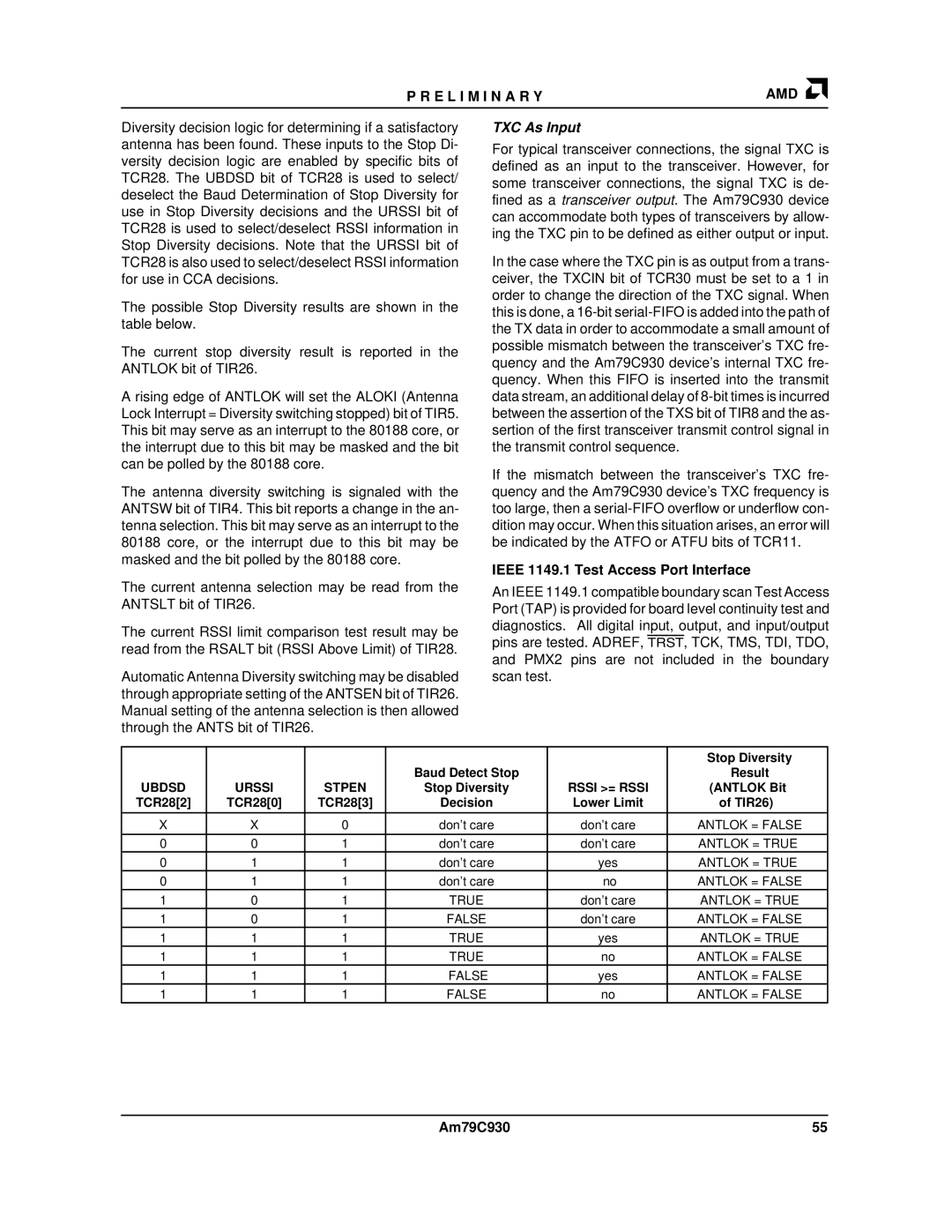
P R E L I M I N A R Y | AMD |
|
|
Diversity decision logic for determining if a satisfactory antenna has been found. These inputs to the Stop Di- versity decision logic are enabled by specific bits of TCR28. The UBDSD bit of TCR28 is used to select/ deselect the Baud Determination of Stop Diversity for use in Stop Diversity decisions and the URSSI bit of TCR28 is used to select/deselect RSSI information in Stop Diversity decisions. Note that the URSSI bit of TCR28 is also used to select/deselect RSSI information for use in CCA decisions.
The possible Stop Diversity results are shown in the table below.
The current stop diversity result is reported in the ANTLOK bit of TIR26.
A rising edge of ANTLOK will set the ALOKI (Antenna Lock Interrupt = Diversity switching stopped) bit of TIR5. This bit may serve as an interrupt to the 80188 core, or the interrupt due to this bit may be masked and the bit can be polled by the 80188 core.
The antenna diversity switching is signaled with the ANTSW bit of TIR4. This bit reports a change in the an- tenna selection. This bit may serve as an interrupt to the 80188 core, or the interrupt due to this bit may be masked and the bit polled by the 80188 core.
The current antenna selection may be read from the ANTSLT bit of TIR26.
The current RSSI limit comparison test result may be read from the RSALT bit (RSSI Above Limit) of TIR28.
Automatic Antenna Diversity switching may be disabled through appropriate setting of the ANTSEN bit of TIR26. Manual setting of the antenna selection is then allowed through the ANTS bit of TIR26.
TXC As Input
For typical transceiver connections, the signal TXC is defined as an input to the transceiver. However, for some transceiver connections, the signal TXC is de- fined as a transceiver output. The Am79C930 device can accommodate both types of transceivers by allow- ing the TXC pin to be defined as either output or input.
In the case where the TXC pin is as output from a trans- ceiver, the TXCIN bit of TCR30 must be set to a 1 in order to change the direction of the TXC signal. When this is done, a
If the mismatch between the transceiver's TXC fre- quency and the Am79C930 device's TXC frequency is too large, then a
IEEE 1149.1 Test Access Port Interface
An IEEE 1149.1 compatible boundary scan Test Access Port (TAP) is provided for board level continuity test and diagnostics. All digital input, output, and input/output pins are tested. ADREF, TRST, TCK, TMS, TDI, TDO, and PMX2 pins are not included in the boundary scan test.
|
|
|
|
| Stop Diversity |
|
|
| Baud Detect Stop |
| Result |
UBDSD | URSSI | STPEN | Stop Diversity | RSSI >= RSSI | (ANTLOK Bit |
TCR28[2] | TCR28[0] | TCR28[3] | Decision | Lower Limit | of TIR26) |
|
|
|
|
|
|
X | X | 0 | don't care | don't care | ANTLOK = FALSE |
|
|
|
|
|
|
0 | 0 | 1 | don't care | don't care | ANTLOK = TRUE |
0 | 1 | 1 | don't care | yes | ANTLOK = TRUE |
0 | 1 | 1 | don't care | no | ANTLOK = FALSE |
1 | 0 | 1 | TRUE | don't care | ANTLOK = TRUE |
1 | 0 | 1 | FALSE | don't care | ANTLOK = FALSE |
1 | 1 | 1 | TRUE | yes | ANTLOK = TRUE |
1 | 1 | 1 | TRUE | no | ANTLOK = FALSE |
1 | 1 | 1 | FALSE | yes | ANTLOK = FALSE |
1 | 1 | 1 | FALSE | no | ANTLOK = FALSE |
Am79C930 | 55 |
